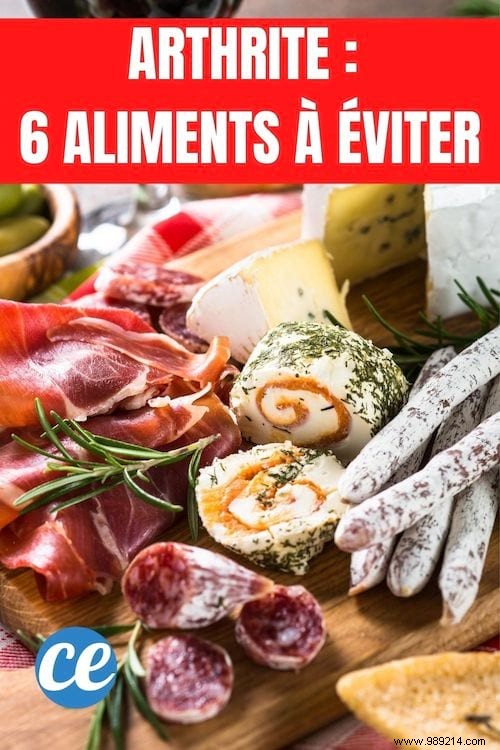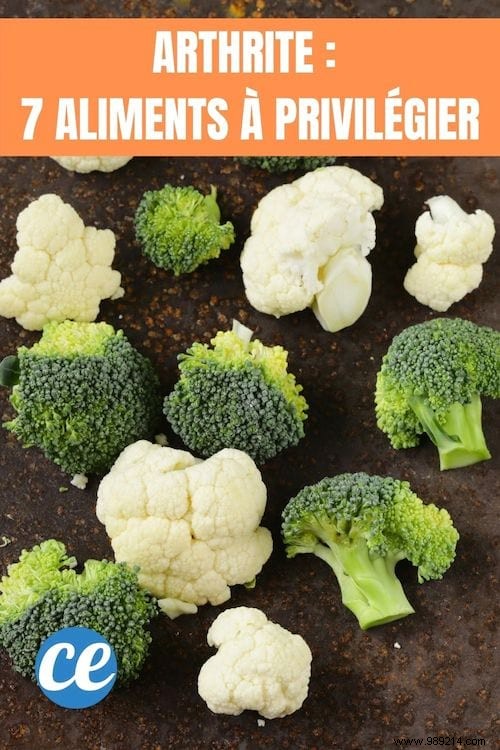
Do you have arthritis? It's very painful...
Arthritis is an inflammatory disease that targets the joints, including the feet, hands, fingers or shoulders.
Did you know that diet is a determining factor in treating and avoiding arthritis?
The goal is to eliminate products that promote joint inflammation.
It is the best natural treatment to relieve arthritis or polyarthritis! It's true, health starts with the plate.
To help you, we have listed the foods to avoid, but also those you should eat instead. Watch:


Here are 6 foods to avoid when you have arthritis and 7 foods to eat instead to relieve or avoid arthritis.
Have you noticed that joint pain is worse when you drink alcohol?
Alcohol is indeed an aggravating factor. And you don't need to drink a lot for the negative effects to be felt! One or two glasses are enough.
No need to rush on the sodas!
Their composition is not very healthy and their ingredients aggravate inflammation and therefore pain.
Why not try a detox drink instead, like cucumber water?
It's much better for your health but also much more economical!
To discover: How Sodas DESTROY Your Body.
It's true that a good baguette is good. But don't overdo it!
Why ? Because refined carbohydrates what's in white bread may promote inflammation.
In addition, on the nutritional level, white bread does not provide much...
Instead, prefer wholemeal bread, much richer in fiber, vitamins and minerals and if possible organic.
And the same goes for pasta! Choose organic wholemeal pasta.
To discover: Diet:How to Avoid Headaches? Eat Whole Wheat Bread.
It's no secret that fries and crisps are the number one enemy of your line...
But in addition, these fatty foods promote the proliferation of inflammatory substances in the body.
Indeed, most of the time, they are cooked in oils full of omega-6 fatty acids:they are the ones that promote inflammation.
Not to mention that fries like crisps are usually full of salt!
As a result, when you suffer from arthritis, you have to avoid these foods!
To discover: Cancer in a Tube:The Horrible Truth About Pringles Chips.
Both sugar and saturated fats are inflammatory agents.
Ice cream, cakes, sweets are saturated with sugar and saturated fat.
Avoid eating it as much as possible and prefer healthy substitutes like the ones we've listed here.
It's also a good idea to bake your own cakes.
Not only can you replace the sugar with a natural substitute like coconut blossom sugar, but you also know the composition of your cake!
In addition it is much more economical.
Either way, try replacing butter and cream with low-fat yogurt and lower your sugar intake.
Beware of margarine:it's a fake friend full of trans fatty acids... So avoid it too!
Then again, some oils are not your friends!
Safflower, sunflower, soy or corn oils are rich in pro-inflammatory fatty acids:omega-6 fatty acids.
Indeed, these oils contain more omega-6 fatty acids than omega-3 fatty acids.
Exactly what you should avoid!
Not to be confused with omega-3 fatty acids which are anti-inflammatory.
You can find these good fatty acids in avocado, walnut, flax or cod liver oils.
The scientific studies are formal!
They clearly established a link between vegetarian diet and reduction of inflammatory reactions in people with rheumatoid arthritis.
So a piece of advice:reduce your consumption of meat and sausages today!
Meat, especially red meat, promotes inflammation in the body.
It is acidifying because of their saturated fats, their high content of omega-6 and iron.
In addition, it prevents the proper assimilation of omega-3s by the body.
White meats are less fatty, but the digestion of white meats generates inflammatory acids.
And deli meats are high in saturated fat and sodium, like many processed foods.
In addition, by eating less meat, not only will you preserve your health, but you will also save money.
Worried about protein deficiencies?
Simply replace meat with foods high in plant protein.
They will provide you with a sufficient vegetable protein source.
Rest assured ! Nothing prevents you from eating a little meat from time to time, but by choosing good quality meat!
Note also that animal milk and cheese are often considered aggravating factors.
There are no studies to prove this, but many people experience improvement when they decrease their intake of dairy products.
Might be worth a try, right?

Fortunately, there are foods that, on the contrary, prevent and relieve arthritis.
They are also the basis of the Cretan diet, so renowned for its health benefits.
Here are 7 foods to eat when you have arthritis:
The alliaceae refer to the family of garlic, onions, chives, shallots, spring onions without forgetting leeks!
Thanks to their sulfur compounds, such as allicin, all of them are powerful anti-inflammatories.
They are therefore to be consumed without moderation.
For example, you can make a leek quiche, an onion soup, small garlic and tomato flans or flavor your vinegar with shallots.
It's good, easy and cheap.
And if you're worried about crying when you peel the onions, here are 7 tips for peeling them without shedding a tear.
Flavor your dishes with spring onions, shallots or chives. And don't hesitate to spice up your shrimp dishes with garlic.
To discover: If You Eat Garlic And Honey On An Empty For 7 Days, This Is What Happens To Your Body.
Some oils should be avoided. On the other hand, others must be an integral part of your diet.
These include rapeseed, extra-virgin olive or linseed oils. They are important sources of omega-3s and have proven anti-inflammatory effects.
Olive oil, for example, is the basis of the Cretan diet.
It is rich in monounsaturated fatty acid, oleic acid and oleocanthal (an antioxidant polyphenol) and promotes the development of enzymes involved in inflammation.
It is used for seasoning and cooking (at 200°C max).
Attention, do not use linseed oil in cooking food.
To discover: 7 Health Benefits of Olive Oil You Should Know.
In short, all vegetables from the cruciferous family. They are rich in vitamins C and K, flavonoids, fiber and sulfur compounds and glucosinolates.
By consuming them, you stimulate the production of enzymes that block inflammatory mechanisms and prevent the destruction of cartilage.
Eat it 3 times a week, preferably raw, or cooked al dente, steamed or in a little water.
Running out of easy recipe ideas?
For example, make chicken with broccoli simmered or au gratin, or baked cauliflower or au gratin.
And never miss cooking cauliflower again with these 3 tips.
To discover: The Trick To Keep Celery And Broccoli Fresh For 4 Weeks.
Oats, quinoa, barley, brown rice...all these cereals contain fibre, vitamins B6 and B9 and vegetable proteins.
They are therefore very useful in fighting inflammation.
For example, you can prepare a delicious quinoa tabbouleh.
It is best to combine them with legumes (broad beans, lentils, dried beans, etc.) to complete the supply of amino acids.
They can then replace meat.
To discover: Can Baking Soda Speed Up Cooking Pulses?
Mackerel, herring, sardines, anchovies, tuna, salmon, eels, halibut... all are super rich in omega-3, selenium, zinc and vitamin D.
They protect the joints from inflammation.
It is best to eat it twice a week, as fresh as possible to preserve the omega-3s:marinated, raw, steamed...
It is better to choose small fish that are less polluted with heavy metals, unlike salmon or swordfish.
To discover: Economical and Easy to Make:The Homemade Rollmops Recipe.
Stock up on raspberries, blueberries, black currants, pomegranates, cranberries, cherries, strawberries and grapes!
They all contain antioxidants, polyphenols, beta-carotene, vitamin C and various minerals.
The tannins and pigments of these fruits are anti-inflammatory.
Kind of like aspirin or ibuprofen.
You can eat them frozen or fresh, but preferably raw to preserve their vitamin C.
On the other hand, it is better to choose them organic, because strawberries, raspberries and cherries are among the red fruits most contaminated by pesticides.
Good smoothies are yours!
To discover: 9 Incredible Strawberry Benefits You Didn't Even Know About.
Not only is it good, but it's also a good source of protein, minerals and antioxidant trace elements (zinc and selenium).
Did you know that the chitin contained in the shell of crustaceans, at the origin of the production of glucosamine, is essential for maintaining the integrity of the cartilage of the joints?
So, treat yourself regularly with mussels, oysters and prawns!
To discover: The Calendar To Pay CHEAPER Fish And Seafood According To The Season.
This term refers to several diseases, whether acute or chronic.
Its origin can be infectious (septic arthritis), immune (rheumatoid arthritis) or metabolic (gout).
It causes the secretion of quinines which are substances that attack the joints.
Symptoms are pain in the joints, especially at night.
The joints can become deformed.
You can also feel a warming in the joints and see redness appear.
Not to be confused with osteoarthritis, which is a "mechanical" disease:the cartilage of the joint wears away until it disappears.
The bones then rub against each other, which is painful.